A Look at Lancaster
by Elizabeth Ashworth
Lancaster is the county town of Lancashire in the north west of England. It is the seat of the Duchy of Lancaster and much of the land is owned by Her Majesty the Queen, who also holds the hereditary title Duke of Lancaster. The town, which became a city in 1937, has a long and interesting history which stretches back to pre-Roman times. The Norman castle, which was originally built as a fortification against the Scots, stands in good repair and is still used as both a court and a prison. Once known as 'The Hanging Town' because more prisoners were sentenced to death here than at any other court in the land, it is famous for the trial of the Lancashire Witches.
In the 18th century Lancaster was an important port as the town was then accessible to sea going ships. Tidal changes resulted in the silting up of the river estuary and nowadays only small boats can sail so far up the River Lune. Most of the fine buildings in the city date from this era of prosperity and the boom in the cotton and slave trade with Africa and the USA.
Nowadays Lancaster is known for its culture, its history and its rapidly expanding University, which was established in 1964.
The Castle
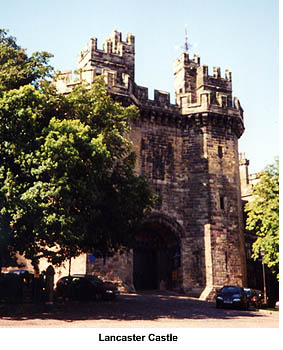 As its name suggests, Lancaster was once a Roman settlement, with a fort, built by the Roman general Agricola, on the site overlooking the River Lune which is today occupied by Lancaster Castle and Lancaster Priory. As its name suggests, Lancaster was once a Roman settlement, with a fort, built by the Roman general Agricola, on the site overlooking the River Lune which is today occupied by Lancaster Castle and Lancaster Priory.
This area of northern England was fiercely fought over after the Norman Conquest by King William of England and the Scots, continuing until 1092 when King William Rufus captured Carlisle and set the border between England and Scotland along the line which still divides it today.
One of William's loyal supporters, Roger of Poitou, was rewarded by the king for his loyalty with the gift of land here, and it was probably around this time that the stone castle was built both as a residence and as a fortification against any further invasion from the north. The castle would originally have been a stone keep surrounded by wooden fencing, but advances in the techniques of warfare, including the use of catapults, meant that in later years, the area surrounding the keep came to be protected by stone walls, with towers at regular intervals from where archers could shoot at the advancing enemy. Interestingly, Lancaster was captured again in 1715 by the Jacobite army, but the occupation lasted only two days.
The ownership of the Castle passed through a succession of noble families and their names and the dates are recorded on an oak panel in the Shire Hall. Then, in 1399, Richard II claimed the Duchy as property of the monarch and the land and surrounding estates remain in the hands of the ruling king or queen to this day.
Apart from some rebuilding after the Civil War, later additions to the Castle include the 14th Century Witches Tower, the impressive gatehouse which was added at the beginning of the 15th Century in the reign of Henry IV; and the 19th Century women's prison. And until the Bankruptcy Act of 1866 it also housed a debtors' prison.
At the end of the 18th Century, a new Crown Court and Shire Hall were begun to the designs of Thomas Harrison, and were completed in 1798. Because of its security, high profile trials are still held here.
In 1821 a women's prison was built to a design by Joseph Gandy. It was designed to be a semi circle that contained five tiers of cells leading off a central gallery, so that a large number of prisoners could be supervised from one central point. It is still being used for its original purpose today, though its inmates are now male prisoners. And the conditions are an improvement on the original damp and completely dark dungeon, where visitors can get a taste of what imprisonment would have once been like as the guide clangs shut the huge door of three inch thick oak with metal studs, leaving them for a few moments, that seem like hours, in the disorientating and terrifying blackness.
Next to the dungeons is Hadrian's Tower, part of the original defensive structure, which used to house the lunatic asylum and where there is now an exhibition of instruments of torture and restraint, including long and short striding chains used on prisoners who were deported to Australia.
Also on display, in the Shire Hall, is the branding iron used to mark criminals as 'Wrongdoers' or 'Malefactors'; and the Drop Room, now used as the Jury Room, where after the year 1800, prisoners were brought before being taken out through the door to their public hanging -- a spectacle witnessed by thousands, including children from the local grammar school, who were given the morning off to watch. Before 1800 prisoners were taken to Gallows Hill, near Williamson Park, to be executed, though they were allowed to stop on the way at the Golden Lion pub for one last drink.
One of the most famous trials held at the Castle was that of the Pendle Witches in 1612. In the reign of James I there was a great fear of witches and many women who seemed a little out of the ordinary were rounded up and accused. In Lancashire, a group of women who lived in an area around Pendle Hill were tried, condemned and hanged at Lancaster for practising witchcraft.
Although the major part of the castle is still in use as a prison you can visit the law courts, the Shire Hall, with its display of heraldic shields, and the dungeons. The castle is open to visitors all year round between 10 am and 5 pm, with guided tours every thirty minute, though the visit may be restricted if the court is sitting. For more information go to .
Judges' Lodgings
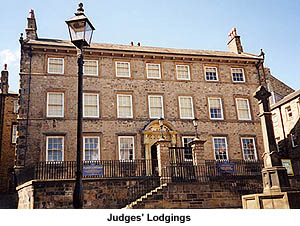 The Judges' Lodgings was once the home of Thomas Covell, who was the Keeper of Lancaster Castle. He died in 1639 and there is a commemorative plaque in the Priory. The house, which is the oldest town house in Lancaster, was where judges stayed when the Assize Courts were in session in Lancaster Castle. The building is now split into two museums. As well as the robes worn by the judges, which are displayed in what was the Senior Judge's Bedroom, the Gillow Museum has an impressive collection of furniture made by Gillows of Lancaster. The furniture making business was founded in 1728 using mahogany which arrived as packing material around other cargoes. The Judges' Lodgings was once the home of Thomas Covell, who was the Keeper of Lancaster Castle. He died in 1639 and there is a commemorative plaque in the Priory. The house, which is the oldest town house in Lancaster, was where judges stayed when the Assize Courts were in session in Lancaster Castle. The building is now split into two museums. As well as the robes worn by the judges, which are displayed in what was the Senior Judge's Bedroom, the Gillow Museum has an impressive collection of furniture made by Gillows of Lancaster. The furniture making business was founded in 1728 using mahogany which arrived as packing material around other cargoes.
On the top floor is the Museum of Childhood which includes a play room for children where they can try out careful reproductions of traditional games, as well as a see a recreation of a schoolroom from 1900. Meanwhile, parents can take in the superb view across Lancaster.
Contact the museum at judges.lodgings@mus.lancscc.gov.uk for more information about opening times.
The Priory Church of St Mary
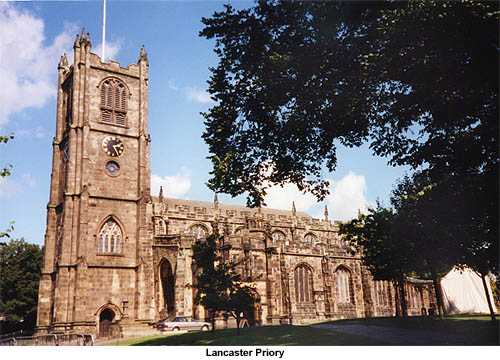
Near to the Castle, and also on the site of the Roman Fort is Lancaster Priory and Parish Church, where Roman remains have been found beneath the chancel. Most of what you will see dates from the 15th Century although the Priory was founded in the 11th Century and there has been a church here since 630 AD. The doorway at the west end of the church appears to be Saxon in origin and in the north aisle there are some sculptured stones of the same period.
In 1094, Roger de Poitou bestowed the Benedictine Abbey of Saint Martin of Seez in Normandy, France, with the Church of Saint Mary of Lancaster. Provision was made for up to twenty people to claim sanctuary and remain here in safety until the end of their lives. They were to be supervised by a governor, in a place specially set aside for the purpose, probably at the west end on the north side of the tower, though no record remains of what these people were fleeing from. In 1133, the Abbot of Seez confirmed with the Pope, the right of the Prior of Lancaster to collect tithes for the sustenance of the monks who were to celebrate Divine Service at Lancaster.
However in both 1322 and again in 1389 Scottish armies invaded, and, although the Priory and the Castle seem to have been spared, much of Lancaster was destroyed. And in 1349, the Black Death killed 3000 people in Lancaster -- over half the population of the town -- and Priory income fell to £26-13s-4d per year.
In 1414, wars with France ended the association of the Priory with its headquarters in Normandy and King Henry V handed over the running of Lancaster Priory to the Bishop of Durham and other trustees who decided to give it to an English monastic house -- Brigittine Convent of Syon at Syon Park in Middlesex. The priory then survived until 1539 and the Dissolution of the Monasteries under the reign of Henry VIII which ended 445 years of monks living the religious life in and around St Mary's Church. It isn't clear whether the buildings were deliberately destroyed or just pillaged for their stones, though the parish church remained.
For more information about what you can see here and details of opening times, services and the availability of meals and refreshments in the Refectory visit the priory website.
Roman Bathhouse
As you follow the path from the Priory down to St George's Quay you will see the remains of an archaeological dig which uncovered the remains of a Roman Bathhouse.
St George's Quay
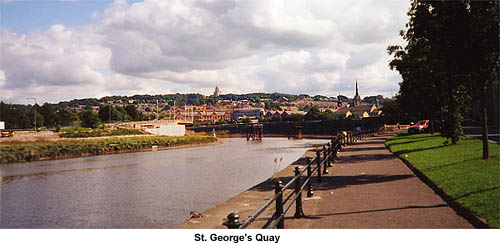
Now restored as a riverfront development, St George's Quay was built between 1750 and 1755 to warehouse tobacco, sugar, rum and cotton. The original Customs House was built in 1765 and was designed by Richard Gillow, son of Robert Gillow who began the furniture making business. It is now a maritime museum, telling the story of Lancaster's maritime trade, the history of the port, the building of the Lancaster Canal, and the fishing industry in the Lune estuary. It features four restored local fishing vessels, and an aquarium. It's open daily and there is also a shop and a cafe.
Cottage Museum
Set in a tiny 18th century cottage, just across the road from the Judges' Lodgings, here you can meet the Victorian housekeeper and learn more about early Victorian life in Lancaster.
Lancaster City Museum
Situated in the centre of the city, in Market Square, in a Georgian building you can learn more about Lancaster's history here. It is open from 10 am to 5 p m daily, except Sundays, and admission is free.
Williamson Park and the Ashton Memorial
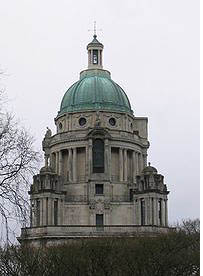 Williamson Park is on the edge of the moors and looks down over the city. The original Edwardian Palm House is now a Butterfly House where visitors can wander freely through the recreation of a tropical forest and watch the butterflies. Williamson Park is on the edge of the moors and looks down over the city. The original Edwardian Palm House is now a Butterfly House where visitors can wander freely through the recreation of a tropical forest and watch the butterflies.
The domed building at the highest point of the park which dominates the skyline and can be clearly scene from the motorway is the Ashton Memorial Folly. Designed by John Belcher, it is built of Portland stone and has a copper dome. It was built by Lord Ashton, formerly James Williamson, who became a millionaire through producing linoleum which was exported from Lancaster to destinations all over the world. He built it as a memorial to his family and also donated money to the Priory for a peal of bells and a new clock.
From pre-Roman to more modern times, Lancaster has been an important town and city. Its history traces the many changes throughout hundreds of years of British history. It's also a small and welcoming place to visit and, set in the beautiful countryside of the north west, is well worth including on a journey from the south of England to the Lake District.
The town is easily accessible from the M6 motorway as you travel north towards the Lake District. It is also served by bus and train stations.
Related Articles:
- Timeline: Lancaster, by Darcy Lewis
- https://www.timetravel-britain.com/articles/towns/lanctime.shtml
- Hidden Churches of Lancashire, Manchester and Liverpool, by Louise Simmons
- https://www.timetravel-britain.com/articles/churches/lancashire.shtml
- Pace Egging - A Lancashire Tradition, by John Ravenscroft
- https://www.timetravel-britain.com/articles/history/page-egging.shtml
- Wakes Weeks: From the Saints to the Sea, by Elizabeth Ashworth
- https://www.timetravel-britain.com/articles/history/wakes.shtml
- A Taste of Lancashire: Eccles Cakes and Hot Pots, by Dawn Copeman
- https://www.timetravel-britain.com/articles/taste/taste03.shtml
More Information:
We regret that we no longer have the resources to maintain up-to-date links and/or hours and pricing details for the various sites and attractions listed on this website. For more information about the location(s) listed above, please use your favorite search engine or visit Wikipedia.
Elizabeth Ashworth writes fiction and nonfiction for both adults and children. Her short stories have appeared in such publications as Christian Herald, People's Friend, Take a Break Fiction Feast, My Weekly and Parentcare; her nonfiction has appeared in a variety of magazines, including The Lady, Lancashire Life and My Weekly. She is also a regular contributor to Lancashire Magazine. Her books include Champion Lancastrians (Sigma Press, 2006) and Tales of Old Lancashire (Countryside Books, 2007); she is currently working on a book on Lancashire Graves, and a novel titled "The De Lacy Inheritance."
Article and photos © 2005 Elizabeth Ashworth
| 